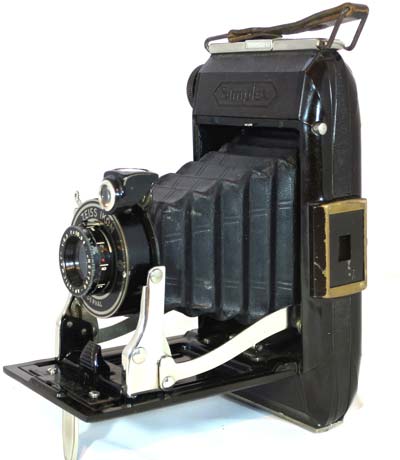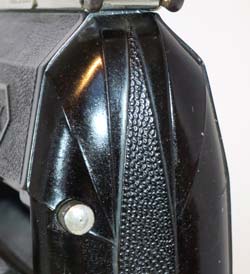Zeiss Ikon Simplex 511/2
Specification

| Manufacturer | : | Zeiss Ikon |
|---|---|---|
| Produced | : | 1935 -1937 |
| Classification | : | Medium Format |
| Body Type | : | Folding Bed |
| Bellows Deployment | : | Self Erecting |
| Construction | : | Bakelite |
| Film Type | : | 120 |
| Film Width | : | 62mm |
| Image Size | : | 6 x 9 cm |
| No. of Images | : | 8 |
| Lens Type | : | Nettar Anastigmat |
| Focus Type | : | Variable |
| Focal Length | : | 105mm |
| Focal Range | : | 2m - inf. |
| Aperture Type | : | Iris |
| Apertures | : | f/6.3 - f/32 |
| Shutter Type | : | Self-cocking leaf |
| Shutter Speeds | : | T,B, I(1/100s, 1/50s, 1/25s) |
| Size Open (w x h x d) | : | 92 x 165 x 135 mm |
| Size Closed (w x h x d) | : | 92 x 165 x 45 mm |
| Weight | : | 590g |
Art Deco Credentials
![]()
![]()
![]()
![]()
Significant: Pronounced and self evident

I consider this camera to warrant 4 stars for the following attributes:
- produced during the main Art Deco period
- brown Bakelite
- elongated hexagonal design embossed onto the back
- rounded and decorative body corners
- chrome and black shutter plate
- decorative chrome struts
- decorative chrome table stand
- chrome back panel release
Description
The Simplex is a striking camera molded in dark brown Bakelite. It has a distinctive Art Deco style although the rounded corners gives it a Steamline Moderne character. It is the only Bakelite camera made by Zeiss Ikon. The camera is a self erecting design for 6x9cm images on 120 film. It is fitted with a 105/6.3 Nettar lens in either a Telma or Derval shutter. The camera shown has a Derval shutter.
The Simplex has a swivelling viewfinder for portrait and landscape operation and also has a pop-up frame viewfinder. It has two tripod mounts and a sliding cover over its red window.
How to Use
Shutter speeds are 1/25s, 1/50s and 1/100s although the accuracy is not guaranteed.
If you don't want to bother with an exposure meter, follow the guide shown. It is based on the 'Sunny 16' rule. Film is so forgiving and will produce acceptable results even when overexposed by 2 or 3 stops or underexposed by 1 stop.
Remember that the exposure guide in the camera user manual may not be helpful as it is based on the use of old film with a low ISO value.
The tables assume that the sun is at least 30 degrees above the horizon - that's 10am - 5pm on a summer's day in the UK.
If you are not sure about the light level, err on the side of overexposure - i.e. assume the smaller f number.
Where there is a choice, a larger f number will give a larger depth of field.
For the slower speeds, you may need a tripod to stop blur through shake.
Using ISO 100/125 film
| Weather Conditions | Shadow Detail | Shutter Speed (s) | ||
|---|---|---|---|---|
| 1/25 | 1/50 | 1/100 | ||
 Sunny SunnySnow/Sand | Dark with sharp edges | f/32 | f/22 | |
 Sunny Sunny | Distinct | f/32 | f/22 | f/16 |
 Slight Overcast Slight Overcast | Soft around edges | f/22 | f/16 | f/11 |
 Overcast Overcast | Barely visible | f/16 | f/11 | f/8 |
 Heavy Overcast Heavy Overcast | None | f/11 | f/8 | f/6.3 |
 Open Shade Open Shade/Sunset | None | f/8 | f/6.3 | |